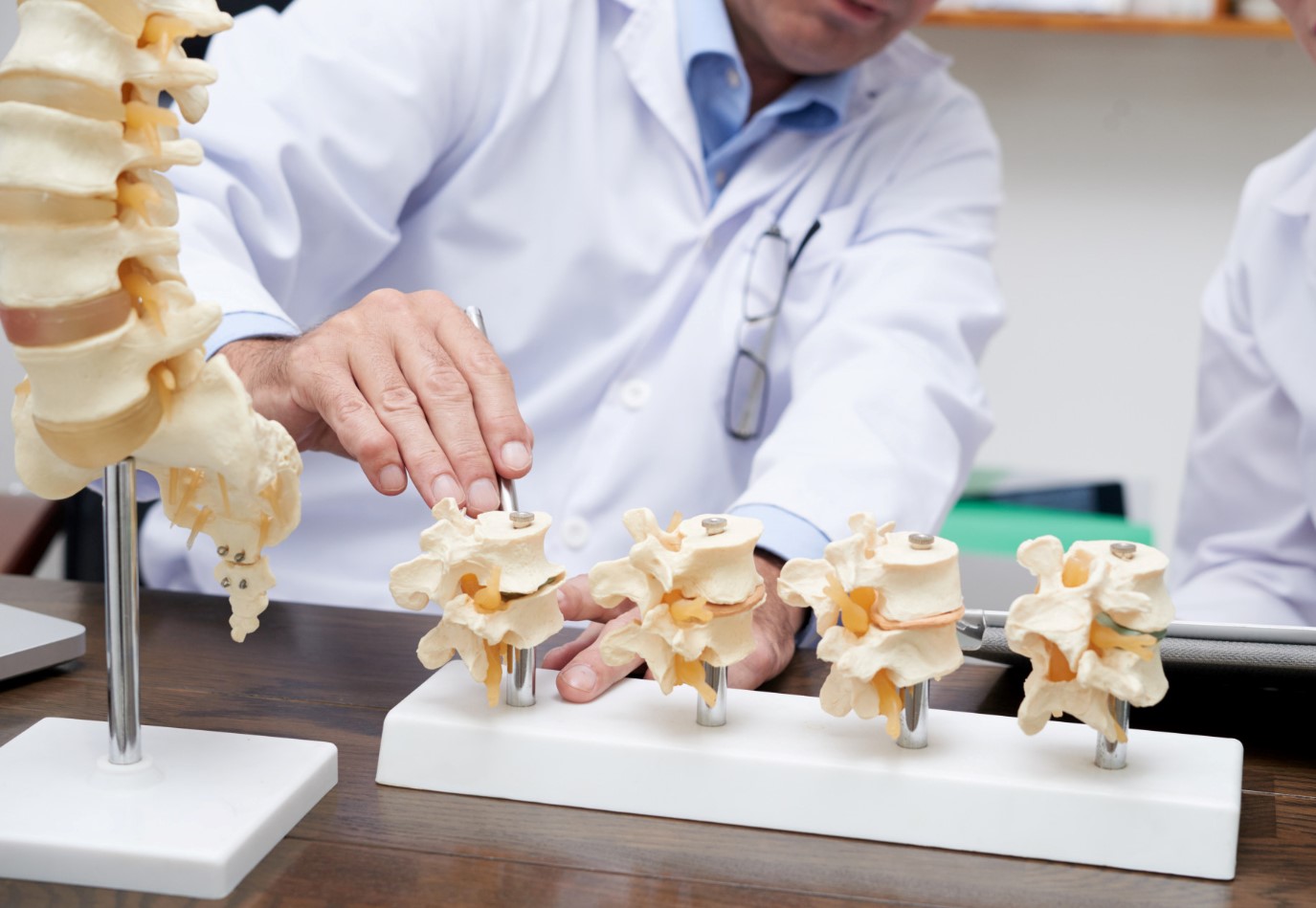What Is A Slipped Disc
A slipped disc, also known as a herniated or prolapsed disc, is a spinal condition wherein the inner material of an intervertebral disc protrudes through its tougher, outer casing. This can lead to compression or irritation of the adjacent nerve roots or spinal cord, and result in symptoms such as back pain, sciatica (shooting pain into the legs), numbness, and even muscle weakness.
Slipped discs have the potential to impair mobility and quality of life, and can occur in any part of the spine but are most common in the lumbar region, affecting the lower back.
Treatment options for a slipped disc are categorised into non-surgical and surgical approaches. Non-surgical methods include physical therapy, medication pain management, and activity modification. For severe or unresponsive cases, surgical options such as discectomy, laminectomy, or spinal fusions may be considered.
Anatomy of the Spine
Vertebral Column
The vertebral column, commonly referred to as the spine, is a bony structure composed of 33 vertebrae. These vertebrae are categorised into five regions:
- Cervical: Comprising 7 vertebrae located in the neck.
- Thoracic: Consisting of 12 vertebrae aligned with the chest and upper back.
- Lumbar: Includes 5 vertebrae found in the lower back.
- Sacral: Composed of 5 fused vertebrae that form the sacrum, at the base of the spine.
- Coccygeal: Consists of 4 fused vertebrae that make up the coccyx, or tailbone.
Each vertebra is separated by an intervertebral disc and is associated with a set of facet joints that facilitate spinal movement. The vertebrae encase the spinal cord, a bundle of nerves that transmit signals between the brain and the rest of the body.
Roles of Intervertebral Discs
Intervertebral discs serve crucial functions within the vertebral column:
- Cushioning Effect: The discs act as cushions that absorb and distribute the mechanical stress exerted on the spine during activities like lifting, bending, and twisting.
- Facilitation of Movement: Intervertebral discs enable a range of motions by acting as a flexible buffer between the rigid vertebrae, including flexion and extension of the spinal column.
- Spinal Stability: Discs contribute to the overall stability of the spine by maintaining the integrity of the vertebral alignment, particularly under load-bearing conditions.
Each intervertebral disc is composed of two parts:
- Annulus Fibrosus: The tough outer layer made of fibrocartilage, which provides structure and strength.
- Nucleus Pulposus: The softer, gel-like inner core that provides cushioning and flexibility.
How A Slipped Disc Occurs
A slipped disc takes place through a series of changes in the structural integrity of the intervertebral disc. Under normal circumstances, each disc is composed of a tough outer layer called the annulus fibrosus and a soft, gel-like core known as the nucleus pulposus.
- Initial Tear: The process often begins with a small tear or fissure in the annulus fibrosus. This may be the result of mechanical stress due to activities like lifting heavy objects, twisting, or a sudden impact.
- Protrusion: As the annulus fibrosus weakens, the nucleus pulposus may start to move from its central position towards the tear in the outer layer.
- Herniation: The nucleus pulposus may herniate through the tear, causing it to bulge outward. In this protruded state, the disc material can compress or irritate surrounding nerve structures.
- Nerve Involvement: The compression or irritation of nerve roots or the spinal cord can result in pain, numbness, and muscle weakness, often radiating to other parts of the body depending on the affected nerve.
Causes of Slipped Disc
Physical Trauma
A direct physical impact, such as that sustained in a car accident or a fall, can exert significant force on the spine, causing a disc to herniate. The abrupt, intense pressure can tear the annulus fibrosus, facilitating the protrusion of the nucleus pulposus and thereby leading to a slipped disc.
Repetitive Strain
Occupations or activities that involve repetitive lifting, bending, or twisting motions can induce chronic mechanical stress on the spine. Over time, this recurrent strain may weaken the annulus fibrosus, increasing the risk of a slipped disc. This often develops gradually but can be aggravated by a single strenuous event.
Symptoms Of Slipped Disc
Lower Back Pain
One of the most prevalent symptoms is back pain, which can range from dull aches to sharp, debilitating discomfort. The pain usually originates at the site of the slipped disc and may worsen during certain activities like bending or lifting. The intensity can also vary depending on the degree of nerve compression or irritation.
Numbness and Tingling in Extremities
Patients may experience numbness or a tingling sensation in the extremities. For lumbar disc herniation, these symptoms often radiate to the lower limbs. In cases of cervical disc herniation, the arms and hands may be affected. The sensation is generally described as ‘pins and needles’ and can fluctuate in severity.
Muscle Weakness
The compression or irritation of nerve roots can disrupt the motor signals from the spinal cord to the muscles. This disruption can lead to muscle weakness and decreased ability to perform routine tasks. In severe cases, it may cause difficulty in walking.
Sciatica
Sciatica is a specific symptom resulting from the compression of the sciatic nerve, commonly due to a slipped disc in the lumbar spine. It is characterized by a sharp, shooting pain that starts in the lower back and radiates down one leg, often reaching the foot. This condition may also be accompanied by numbness and tingling sensations in the affected leg.
Investigations
Magnetic Resonance Imaging (MRI)
MRI is the imaging modality of choice for diagnosing a slipped disc. It provides detailed images of both bone and soft tissue, enabling the clinician to visualize the disc herniation and any associated nerve compression. MRI scans can differentiate between disc material and surrounding structures.
X-Ray
An X-ray primarily visualizes the bony structures and does not provide detailed images of soft tissue like intervertebral discs. However, it can be useful in ruling out other conditions that may mimic the symptoms of a slipped disc, such as fractures or spinal deformities.
Treatment Options
Non-surgical Treatments
-
- Physical Therapy: Involves a regimen of targeted exercises aimed at improving spinal alignment, enhancing muscle strength, and promoting mobility. Therapists may also employ modalities like heat or ice application to alleviate pain.
- Pain Management
- Analgesics: Over-the-counter pain medications like non-steroidal anti-inflammatory drugs (NSAIDs) are commonly used for pain relief.
- Corticosteroid Injections: Administered locally into the affected area, these injections reduce inflammation and provide temporary relief from pain. They are generally considered for cases with severe or persistent pain.
- Rest and Activity Modification: Temporary avoidance of activities that exacerbate the symptoms is often advised. A period of rest may be beneficial in allowing the inflamed tissue to heal. However, prolonged inactivity is not recommended, as it can lead to muscle atrophy and worsened symptoms.
Surgical Treatments
- Discectomy: The herniated portion of the disc is removed to relieve pressure on adjacent nerves. The operation is typically recommended when non-surgical methods fail to alleviate symptoms or when nerve compression leads to significant functional impairment.
- Laminectomy: Involves the removal of the lamina, a part of the vertebral bone, to create more space for the nerves. It is often performed in conjunction with discectomy to facilitate easier access to the affected disc.
- Spinal Fusions: Fusing two or more vertebrae may be necessary for those involving significant vertebral instability. This procedure is done using bone grafts, metal rods, or screws to stabilise the spinal column.
- Minimally Invasive Procedures: Aim to achieve the same outcomes as traditional surgery but with smaller incisions, reduced tissue damage, and quicker recovery times.
What is the recovery time after slipped disc surgery?
Recovery timelines vary depending on the surgical procedure performed:
- Discectomy: Most patients can expect to return to light activities within 2–6 weeks.</span
- Laminectomy: Recovery typically takes 4–8 weeks, depending on the extent of the surgery.
- Spinal Fusions: The recovery period is generally longer, ranging from 3–6 months.
- Minimally Invasive Procedures: These usually have quicker recovery times, often within 2–4 weeks.
Is slipped disc surgery safe?
Surgery for a slipped disc is generally considered safe, but like any surgical procedure, it carries some risks:
- Infection: Occurs in a small percentage of cases and is usually treatable with antibiotics.
- Nerve Damage: A rare but serious complication affecting motor function or sensation.
- Recurrent Disc Herniation: Occurs in about 5–10% of cases.
The success rate for relieving pain and improving function is high, often exceeding 80–90%.
Can a slipped disc heal on its own?
In some instances, a slipped disc may resolve without surgical intervention. Non-surgical treatments like rest, physical therapy, and pain management can often alleviate symptoms. Spontaneous resorption of the herniated disc material is also possible but less common.
What are the long-term effects of a slipped disc?
Untreated or inadequately managed, a slipped disc can lead to chronic pain and decreased quality of life. Potential complications include:
- Chronic Back or Leg Pain: Persistent pain can interfere with daily activities.
- Nerve Damage: Prolonged compression of nerve roots may lead to permanent loss of sensation or motor function.
- Cauda Equina Syndrome: A severe, but rare condition where the bundle of nerve roots at the lower end of the spinal cord is compressed, requiring immediate surgical intervention.


